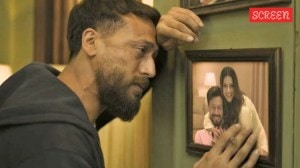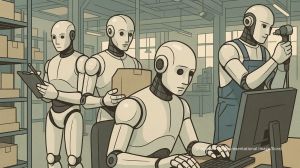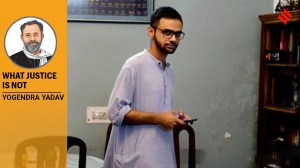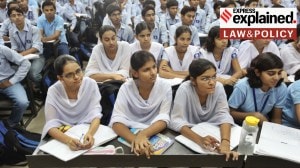Delhi is the only megacity that has an extraordinary historical past
<B>BBCs Delhi correspondent and novelist</B> <B><font color="#cc000">Sam Miller</font></B> shares his views in an interaction with the Delhi Newsline team. Having declared Delhi his home,Miller recently launched his novel on it,Delhi: Adventures in a Megacity
Sam Miller,in his own words,is a rare phenomena in Delhi: the ‘foreigner on foot.’ After studying History in Cambridge and Politics at School of Oriental and African Studies,Miller has worked with the BBC as editor,Current News Affairs,South East Asia. But he has now declared Delhi his home,and has just come out with a Penguin novel,Delhi: Adventures in a Megacity. In an interaction with the Delhi Newsline team,he shares some of those adventuresfrom a shit squirting ‘scam’,on how South Delhi doesn’t know West Delhi,the reasons why Congress won,and the city which has shaped his life:
•Shailaja Bajpai: You were first posted in Delhi in 1990’s and then you came back to the city in 2002. Taking us back to the walks that you took in ’90s,tell us something about the difference in walking in Delhi since then.
Sam Miller: I did not like Delhi very much when I first lived here. One of the things that I found difficult here was to very hard to walk here. It’s still not terribly easy now. But it was really difficult for a foreigner. I would try to walk across the roads and people would block the roads with auto rickshaws,taxis. There were no proper maps of the city in those days. And I felt rather constrained and constricted within Nizammudin where I lived in.
I returned to Delhi in 2002 end and moved into an office in Gopaldas Bhawan in CP and started exploring the area during lunch time. And there was an Eicher map that covered Delhi pretty well. Gradually,I began to explore the city. I hated Vasant Vihar where I lived,which was just full of foreigners but had nothing going for it. I startiShailaja Bajpai: You were first posted in Delhi in 1990s and then you came back to the city in 2002. Taking us back to the walks that you took in ’90s,tell us something about the difference in walking in Delhi since then.
•Shailaja Bajpai: Tell us three things that you found really difficult in your journey of walk. There are no pavements in Delhi.
Sam Miller: Generally,three times my auto rickshaws was hit,never very badly though. I fell into a dry manhole once down the airport road. Fortunately,it was not very deep and was being constructed then. I fell into one of the few dry manholes in Delhi! I was also chased by pigs,which I thought funny initially but then a woman at a dhaba told me that a child was mauled to death by pigs in Samaipur Badli. And I was very much near there!
I never felt threatened in Delhi. I feel I am incredibly welcome in most places. I must have cut a pretty odd figure,because I was not only a foreigner,but a foreigner on foot! Right at the beginning of my book,I tell a story about the shit squirted on my shoe,which is like a scam! I am still waiting to be contradicted on it because I have never met a single Indian to whom this has happened but this has happened to half of the foreigners on one point or the other.There is a subway near Regal Cinema and there is this scam when basically when someone,as you go across,squirts a bit of shit on your shoes. And you come up,there is a shoe shining man,pointing at your shoes and charging you a huge sum of money. And the scam can go further,as some persons have described how the shoe shining man armed with a small razor blade can cut the shoes and would tell you that your shoes need to be stitched up. The scam has gone on and on. But on the whole,the fact of me being a foreigner was a help in a way and it was easy for me because I spanned out so much. We all know for women,Delhi is quite a dangerous place and we read about it everyday. There was one occasion when I felt threatened. It was near the old slaughter house,west of Sadar Bazar. It was around 7 am and I was coming back after seeing off my kids at New Delhi Railway Station. As I walked,I saw this incredible scene of butchery that I cannot quite imagine and I just walked around in a daze because it was like a sort of medieval painting. I talked to some of the butchers and I went into a room where they were killing the cattle. They suddenly turned nasty and unpleasant on me and started joking as to how long it will take to skin me. They had knives. I got scared but I think I was wrong to be scared because they were just having a bit of fun. I picked my phone and rang my wife saying I am coming. Her number was busy and I had to make up a conversation! But they listened to me speaking in English and after that they stopped being menacing,and we all had a laugh then.
•Seema Chishti: Your wife is from Mumbai and so you have a relationship with Mumbai as well. There is always a mental profile for the people from other metropolitan cities. What are your reflections on the people that make Delhi?
Sam Miller: I feel Delhi as a migrant city more than any other city. One of the elements of the migration is that people think they think they are here for few years and I’m going to go back. I am beginning to detect a change in that. The city has reached such a size and has attracted many people who begin seeking favours from the government like in the old days. It is beginning to build its own loyalty. One major difference that will play out for Delhi as against other cities is that it has a proper government of its own. People have a control over the city,it’s their city and it’s their fault if it does not work. In Mumbai and Kolkata,they don’t. So Delhi has opportunity for it,it is more unitary than any other city. There has not been loyalty in Delhi because it has been a city of migrants; it has been decimated so many times. In 1857 and also during the partition this was a city that was deeply traumatized so many times. There were refugee camps around Purana Qila and a large unwilling population from Pakistan. So it’s also been a city which has been forced on people or taken away from some.
•Neha Sinha: How do you see the parallel perspective of India as shown by movies like Slumdog Millionaire and the book The White Tiger?
Sam Miller: from my point of view,I was looking out for what I could see as a story. I train journalists and one of the lines I give them is that there are two stories down every road. Not enough journalists go out and get them. If that shows India in a good or bad light,that was not an issue I was thinking about.
About Slumdog Millionaire,we have to see that it was made for a Western audience. It was going straight to DVD until someone rescued it. My own view of the film,as someone living here,is that I was very uncomfortable with the language. How do you believe that? On portraying the poverty,of course poverty should be portrayed. I mean this is fiction,and they’ve done it very well. I walk in Mumbai and they aren’t really making it up. The idea that you can stop the world from knowing is impossible. It was impossible in the 60’s when BBC was cast out of the country for showing Louis Malle’s documentaries.
•Shailaja Bajpai: as a reporter or while training others,did you go looking for Delhi underbelly?
Sam Miller: I have gone to insalubrious places and wondered what stories I would get out of them. Then I went to Gazipur landfill site,which interestingly sits next to fish and chicken market of Delhi. I climbed the landfill where people lived in shacks but went to their homes nearby over the night. I described meeting a small child,who I presumed did not go to school because it was a weekday and she was sorting through the rubbish. However,she did study after I discovered it was a public holiday. She and other people talked abut their aspirations and ideas for change. One of them had a nephew doing computer science. It was not a kind of fantastic and positive story but it was interesting and different. My expectations were challenged. When we go there,we should not think the poorest of the poor are hopeless. Often they have more interesting things to tell.
•Unni Rajen Shanker: As a migrant,Delhi,for me seems like a city that welcomes you. It never makes you feel an outsider. How do you see Delhi vis-à-vis Mumbai?
Sam Miller: I adore Mumbai but I’ve never lived there. I think Mumbai is stuck in time. It has not changed much since I was there for the first time in 1987.
The transport infrastructure is fundamentally the same as it was before.
I do not know your view about Delhi will be accepted by many women,particularly the woman in their 20s and are single and independent. Many of them have described Delhi to be difficult and stultifying if not quite dangerous. Delhi woman do not feel safe to go home in buses and many woman have told me that and that is appalling. So I think Delhi has quite a lot to be ashamed of. However,Delhi as a migrant city makes it more migrant friendly. There is no community that is in majority. In 1990s,Delhi had a huge Poorvanchali arrivals and it changes the demography of the city. The demographics of the city has had an impact on the recent elections as well. I think one of the reasons BJP lost the elections is because they still think Delhi is a Punjabi city. Congress doesn’t,and one of the instances is the Chatth festival,which is the biggest open air festival and South Delhi hasn’t heard of it. Congress had boards saying ‘Sheila Dikshit welcomes you to Chatth’ and BJP just didn’t.
My personal view is that the demographics of the city have changed and it is good for a city not to be dominated by a community because then it expects it to behave in a particular manner and that should not be the way a big city should be like.
•Amrita Dutta: Does Delhi have a distinctive modernity as far as India is concerned?
Sam Miller: It is too early to say that but I hope it will. The Metro is very impressive. I’m very intrigued to see how it reaches the south Delhi. Will the rich of South Delhi use the Metro? You feel safe,and you see all kinds of classes of people on the Metro. Similarly,the much maligned bus corridor,the whole purpose was that it would be quicker for the buses than the cars. A lot of mistakes were made but you need to learn from those mistakes. I am very interested in the process of self-government. I think change is happening slowly.
•Aanchal Bansal: How does a journalist reinvent himself?
Sam Miller: I think more should be written about peopletheir lives,stories and concerns. We are so tied up with political landscape and other such stories that we convince ourselves that’s what the readers and audience wants.
The worst case in India is with the business journalism. It becomes unintelligible to most people and however accurate it is,it fails every test it if it fails the intelligibility test.
•Esha Roy: Your opinion on electronic media covers news and sting operations?
Sam Miller: Electronic media is expanding rapidly in India; maybe faster in scale than any where else I have come across. But you learn from making mistakes. I want to know what extent lessons have been learnt after mistakes made by the media in covering the Mumbai attacks.
On sting operations,it is a weapon you use very rarely and suddenly it became the flavour of the month. However,its frequent use can reduce it into a joke. The normal results you expect from a sting didn’t happen. It has lost its strength and sting. It is certainly not a replacement for investigative journalism. There is so much that can be gathered by just looking through the balance sheet of corporate houses and that is what business journalists should be doing.
•Mandakini Gahlot: In the present scenario,Delhi cannot be seen in isolation but as the National Capital Region. How do you see that changing the character of the city?
Sam Miller: archaic planning laws in 60s and 70s encouraged the growth of Gurgaon and Noida as unplanned cities literally on the borders of Delhi. A recent report on the Population Research Bureau in Washington said that Delhi is really the biggest city. The state border is not the population border. Gurgaon and Noida became dream towns for the middle classes and suddenly there were affordable housing for them. It’s only late in the day,Delhi authorities realised they should be building cities themselves. I am more impressed by Dwarka than Gurgaon because they laid the sewage lines before they made the city. And the metro reached too. Gurgaon has real problems.
•Sobhana K: Looking at the flyovers being built everyday,do you think we are going the right way?
Sam Miller: It is disastrous if the flyovers are being built only as a solution for traffic problems. I think when the cheaper car arrives,we aren’t going to see an end to the traffic. A flyover can solve the traffic issue for a few years but in the long run,it cannot solve the problem of traffic.
•Aneesha Mathur: Did you come across different kinds of Delhi’s in the same city?
Sam Miller: that’s really what I was trying to do in the book. The lives and attitudes of people who live around Vasant Vihar are totally different from those who live in fancy Vasant Vihar. The lives of the people in different colonies display different forms of Delhi. I live in Panchsheel Park and its interesting; its edged by the Ring Road,and there’s Shahpur Jat,which has small housing in it,then you have Asaid Village,with modern architecture,which is owned by corporates etc. You have so many different worlds in a small area in Delhi. I have hardly come across a person in South Delhi who has been to West Delhi. They might go to North Delhi if they are going to Chandigarh. I had been to Pitam Pura for the Sting concert so I had a bit of an idea. But once when I went to Hindu Rao hospital and looked down from its terrace,I didn’t recognize anything. I was witnessing a different world,which was a huge huge city. I thought as if I was looking at a wrong direction,for this could not be the Delhi I know. It was a new world altogether. It was an entire city,with English books in bookshops and nice restaurants,which not many knew about!
•Amrita Dutta: what do you think is the ugliest building in Delhi?
Sam Miller: I think Sena Bhavan is the worst building in the city,it is falling apart. It’s molding in front of your eyes! Another terrible building is School of Planning and Architecture and ironically it is called the school of architecture!
In terms of beauty,I think LIC building in CP is the most remarkable building. I see it slightly differently each time I see it and can notice something new. It is asymmetrical,I like the way its back and front are different and the way glasses are used. Amongst modern buildings,Bahai temple is an extraordinary special building. There is a kind of warmth and calm to it in the way it stands out. I see it from the plane when I land in Delhi. Humayun’s Tomb is absolutely extraordinary. And for postmodern reasons,Qutub Minar is amazingit’s like a great cigar that towers out. It’s like the oldest postmodern building ever. It also has incredible workmanship on it.
•Sweta Dutta: what has been your most challenging assignment in India and elsewhere?
Sam Miller: I was in Bangladesh to cover the cyclone of 1991 and I was on a helicopter journey with just another journalist to the place devastated by the calamity. I could just see huge piles of bodies everywhere. You do not see bodies in the West as bodies are put in the coffin. I could not believe what I was seeing. I describe have used this in my book to describe death: the look in people’s eyes when they were carrying the dead bodies. Most of the men were wearing just loincloths and there I was,in my nice clothes. It was a sort of interplanetary meeting. The images haunted me then and they still do.
The journalists need to remember they are not machines and they need to still care about people whom they are writing about. You need to remember you are not a bleeding heart in your columns but you also need to remember why you are doing what you are doing. You have to remain humane in what you do.
At the beginning of my career as a reporter,I felt like I couldn’t do it. I got over that,but also,you shouldn’t let it kill you inside.
And journalists are affected by such incidents even if they think they do not because they are sometimes witnesses to the most terrible things.
•Shawan Sen: Your experiences as a reporter in Pakistan and Afghanistan?
Sam Miller: I reported there in late 1980s and early 1990s. I went to Pakistan in an extraordinary time when Soviets had just pulled out and Mujahideen had not moved in. There was a sort of hippie quality to Kabul and I could not believe this was the same city. One could see girls in mini skirts. It was like the late 60s had come 20 years later. However there were not many English speakers.
I had also watched Sholay for the first time there but could not watch the end because the projector caught fire and I tried getting a copy of the movie in London as well but could not find it.
•Anushree Majumdar: What do you think about the rediscovery of Delhi through recent movies like Rang De Basanti and Khosla Ka Ghosla.
Sam Miller: I loved the The Householder which gives a great sense of a city. Movies can be very good ways of capturing cities of certain times. Movies give an incredible sense of the city. Delhi has recently become a great backdrop for movie making.
•Neha Sinha: People in Delhi draw conclusions over the place and locality you reside in. Nursery admissions have funnily enough become a microcosm for that aspirational value. Is Delhi uniquely hostile when it comes to mapping one out by his address?
Sam Miller: I don’t know if it’s uniquely hostile but it’s pretty bad! What we are seeing (of the snobbishness) in upmarket areas there is a breaking down of some of those. Places like CR Park and Defence Colony have now become diluted as far demographics are concerned and I think that’s a welcome sign. It’s important that the diluting happens. I don’t think people should be living with other people like them,they should be mixing,because that’s the point of a city! The difference in different parts of the city is quite strong. But it’s certainly quite bad.
Think what the nursery admissions are like for poor students. I think the whole Nursery system here is a total mess. We need better provisions and better quality education.
•Seema Chishti: How easy does history sit with Delhi today?
Sam Miller: I have a terrible story to tell. A 14th Century half-mosque,which was in the wilderness near my home,was demolished one summer. I think it was unlisted,as many buildings inside the walls of the Siri Fort are. And it was just gone forever! I also understand that in a city with 1500 listed monuments my one little half-mosque doesn’t seem very important. But it’s also worth remembering that in any other city in the world,a 14th Century Mosque of that quality would be a major tourist attraction. There is a blasé-ness about the past here but I realize that might be slowly changing. I think it is a remarkable city. There are only three cities like it,Cairo,Athens and Rome; and maybe Istanbul. But these have populations below 10 million. So this is the only megacity that has that extraordinary historical past. Buildings on the other side of the road from Purana Qila are incredible. One of them is called Khair ul Musajid,which means most beautiful Mosque. But it’s opposite the Purana Qila,so its ‘that ruin opposite the bigger ruin!’
•Shailaja Bajpai: What about Delhi has made you to choose it as the city to live in?
Sam Miller: I did not like Delhi when I came in late 1990s and it was the one of the most polluted cities then. However,during the subsequent visit,I noticed that it had changed. Then it was not only about me. My wife and kids were also here and they were happy. I gradually learnt to love the city despite some of the terrible things. But I think the city is one on the move in a way that makes it exciting. And it wasn’t on the move in the 90’s!
•Shailaja Bajpai: Something else on the move are Bullocks and stray dogs?
Sam Miller: I had an encounter with pigs and goats but not with dogs. However,im always amused whenever a friend comes to see me,and the first day is spent talking about the cows. ‘I saw a cow here!’ they’ve been rounded up a fair bit.
I have a lot of pictures of goats,near Bela road going across the river,a day after Bakr-Id,of the goats who had survived going across the river.
•Sobhana K: what’s your opinion about Delhi airports?
Sam Miller: It is one of the nastiest and most unappealing airports in the world.
Endless queues and not knowing what queue to stand in,security personnel’s behaviour,people forced to crawl as if they were goats,the lack of any comfort,and even seats to sit on. To be fair to the people doing it,they’ve said it’s going to get worse before it gets better.
However,their vision 2010 as posted on their website looks good but it will remain to be seen how they deliver. If they do,it will be a worldclass airport.
•Seema Chishti: why are our entry and exit points at railway stations and bus terminals are unwelcoming?
Sam Miller: what went wrong with the city in 1960s and 70s is that the city planners pretended it was going to be a small city and did not recognize it as a mega city till 90s. The planners did not take into account the unauthorized settlements,and it was absurd. The planning documents look like they are planning for Chandigarh!
•Aneesha Mathur: What do you think about the education system in India?
Sam Miller: Indian education system is fantastic in getting people to exam and to compete at the highest level internationally but is it good at teaching team working skills? I don’t get that impression. I have seen dozens of the offices with employees endlessly going to people up in the food chain for getting things sorted out. It should not have to happen like that. I fear it is a creation of the education system that puts premium on individuals rather than group performance. Is there enough emphasis on creativity and imagination in the system? I feel there is not enough innovation or imagination.
•Mandakini Gahlot: In the run up to Commonwealth Games,everything in the capital seems to be happening as a part of its preparation? What is your take on that?
Sam Miller: it was true of the Asiad in ’82. An event like this gives us a target,a fixed point where people can connect and if the city is improving,I think it is fine. It serves a very useful psychological purpose considering number of projects has been fixed to be completed before the games.
Transcribed by Utkarsh Anand
Photos




- 01
- 02
- 03
- 04
- 05


























